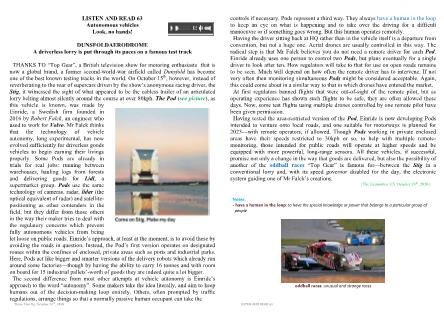Listen and Read 63 - Autonomous vehicles

A driverless lorry is put through its paces on a famous test track
THANKS TO “Top Gear”, a British television show for motoring enthusiasts that is
now a global brand, a former second-world-war airfield called Dunsfold has become
one of the best known testing tracks in the world. On October 15th, however, instead of
reverberating to the roar of supercars driven by the show’s anonymous racing driver, the
Stig, it witnessed the sight of what appeared to be the cabless trailer of an articulated
lorry belting almost silently around the course at over 80kph. The Pod (see picture), as
this vehicle is known, was made by
Einride, a Swedish firm founded in
2016 by Robert Falck, an engineer who
used to work for Volvo. Mr Falck thinks
that the technology of vehicle
autonomy, long experimental, has now
evolved sufficiently for driverless goods
vehicles to begin earning their livin
Thẩm Tâm Vy, October 24th, 2020 LISTEN AND READ 63 LISTEN AND READ 63 Autonomous vehicles Look, no hands! DUNSFOLDAERODROME A driverless lorry is put through its paces on a famous test track THANKS TO “Top Gear”, a British television show for motoring enthusiasts that is now a global brand, a former second-world-war airfield called Dunsfold has become one of the best known testing tracks in the world. On October 15 th , however, instead of reverberating to the roar of supercars driven by the show’s anonymous racing driver, the Stig, it witnessed the sight of what appeared to be the cabless trailer of an articulated lorry belting almost silently around the course at over 80kph. The Pod (see picture), as this vehicle is known, was made by Einride, a Swedish firm founded in 2016 by Robert Falck, an engineer who used to work for Volvo. Mr Falck thinks that the technology of vehicle autonomy, long experimental, has now evolved sufficiently for driverless goods vehicles to begin earning their livings properly. Some Pods are already in trials for real jobs: running between warehouses, hauling logs from forests and delivering goods for Lidl, a supermarket group. Pods use the same technology of cameras, radar, lidar (the optical equivalent of radar) and satellite- positioning as other contenders in the field, but they differ from those others in the way their maker tries to deal with the regulatory concerns which prevent fully autonomous vehicles from being let loose on public roads. Einride’s approach, at least at the moment, is to avoid these by avoiding the roads in question. Instead, the Pod’s first version operates on designated routes within the confines of enclosed, private areas such as ports and industrial parks. Here, Pods act like bigger and smarter versions of the delivery robots which already run around some factories—though by having the ability to carry 16 tonnes and with room on board for 15 industrial pallets’-worth of goods they are indeed quite a lot bigger. The second difference from most other attempts at vehicle autonomy is Einride’s approach to the word “autonomy”. Some makers take the idea literally, and aim to keep humans out of the decision-making loop entirely. Others, often prompted by traffic regulations, arrange things so that a normally passive human occupant can take the controls if necessary. Pods represent a third way. They always have a human in the loop to keep an eye on what is happening and to take over the driving for a difficult manoeuvre or if something goes wrong. But this human operates remotely. Having the driver sitting back at HQ rather than in the vehicle itself is a departure from convention, but not a huge one. Aerial drones are usually controlled in this way. The radical step is that Mr Falck believes you do not need a remote driver for each Pod. Einride already uses one person to control two Pods, but plans eventually for a single driver to look after ten. How regulators will take to that for use on open roads remains to be seen. Much will depend on how often the remote driver has to intervene. If not very often then monitoring simultaneous Pods might be considered acceptable. Again, this could come about in a similar way to that in which drones have entered the market. At first regulators banned flights that were out-of-sight of the remote pilot, but as operating experience has shown such flights to be safe, they are often allowed these days. Now, some test flights using multiple drones controlled by one remote pilot have been given permission. Having tested the area-restricted version of the Pod, Einride is now developing Pods intended to venture onto local roads, and one suitable for motorways is planned for 2023—with remote operators, if allowed. Though Pods working in private enclosed areas have their speeds restricted to 30kph or so, to help with multiple remote- monitoring, those intended for public roads will operate at higher speeds and be equipped with more powerful, long-range sensors. All these vehicles, if successful, promise not only a change in the way that goods are delivered, but also the possibility of another of the oddball races “Top Gear” is famous for—between the Stig in a conventional lorry and, with its speed governor disabled for the day, the electronic system guiding one of Mr Falck’s creations. [The Economist US. October 24th, 2020] Notes: - have a human in the loop: to have the special knowledge or power that belongs to a particular group of people oddball races: unusual and strange races
Tài liệu đính kèm:
 listen_and_read_63_autonomous_vehicles.pdf
listen_and_read_63_autonomous_vehicles.pdf



